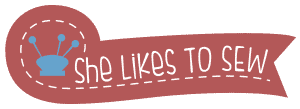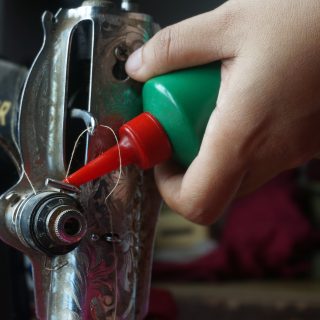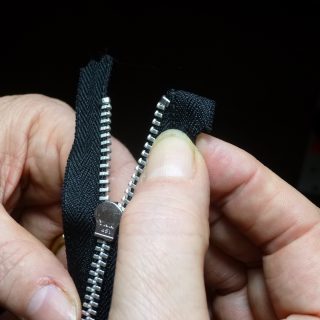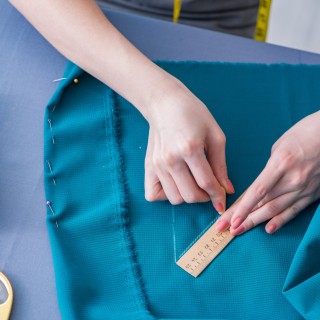So you’ve bought jeans that are slightly bigger at the waist and the store won’t take them back, or you’ve lost a few pounds and now your favorite pair of jeans require a bit of adjusting.
There are several ways to make your jeans waist smaller, depending on whether you want an easy sewing project, or you’re an experienced sewist ready to take on a challenge with putting in a waistband.
I’ve done this many, many times, so I even have a quick-fix solution for when you don’t want to engage in sewing, but simply tighten your waistband with an elastic band.
Method #1: Working With the Sides of the Jeans
The first method I’ll explain is how to alter your jeans waist smaller by pinching the waist at the sides.
- First, turn your jeans inside out.
- Pull the jeans on while they’re inside out.
- Pinch the sides of the waist so it fits.
- Try to make the amount of pinched fabric equal on both sides so the jeans don’t look off-center when you wear them.
- Use two safety pins to help you keep the marks when you take the jeans off.
- The pins should be placed as close to your waist as possible.
- Put as many pins as you need down the sides of the pants (down your hips and thighs) and go as low as you want, to make the jeans as fit as you need them to be.
- If you go all the way to your knee, you will make the jeans skinny-fit, but if you stop along the waist, they will be more straight-shaped.
- Take the jeans off carefully so the pins don’t fall out and you don’t hurt yourself.
- Take your sewing machine and make a single straight stitch right next to your pins.
- The best needle to use for this stitch is the sturdy needle for denim. Use a longer stitch than usual (4 or more) and stitch with higher tension (2 or more). Feel free to experiment with these measurements.
- Give your stitches another pass with a backstitch at the beginning and at the end to make sure that all your stitches are securely in place.
- Turn your jeans back to the right side out and try them on.
- If the fit is not good, you can take your stitches out and try again.
- If the jeans fit well, but there is too much excess fabric inside that’s bothering you, you can turn them back inside out and cut the excess fabric.
- Leave some quarter of an inch of excess fabric so the stitches don’t unravel.
- The other option is to fold the excess fabric and sew it in so it remains flat.
Method 2: Working With the Back of the Jeans
Adjusting at the back of the jeans is a good option if you don’t want to risk making your jeans oblique, but it can be slightly more complicated than the previous procedure.
- Put the jeans on (no need to turn them inside out).
- Pull the waistband on the back and adjust the waist to the size that fits you.
- Use a safety pin to pinch the fabric in place.
- Pinch again a bit below and use a straight pin to secure the fabric.
- Keep pinching down until you’ve pinched all the excess fabric and the jeans fit well on your hips, waist, and thighs. Go as far down as you can along the backside of your jeans, because the further you go, the less noticeable the change will be.
- Watch out not to pinch your underwear (can be tricky when you start pulling your jeans down :)).
- Take your jeans off and put them on a flat surface facing up.
- Pull the front side of the waistband down to see the markings you’ve made with the pins.
- Use fabric chalk or a highlighter to mark along the center of the seam you’ve pinned, just make sure it does leave a line on both sides of the seam.
- Take out the pins.
- Start working from the left to the right side with a seam ripper and take out the top and bottom row of stitches next to the waistband.
- Cut all of the waistline stitches of the two rows along the waistband between the marks you’ve made with chalk or the highlighter, and plus half-an-inch on each side. Make sure you don’t cut out too many stitches by cutting the first and last stitch first. Then, you can pull out all the stitches in between easily just by pulling the excess threads.
- At this point, leave the stitches on the top edge of the waistband as well the seat of the jeans.
- If there are any loops for the belt between the marking lines, remove them by clipping the thread attaching them away.
- If there are any remaining threads from the belt loop you can leave them, because when you later sew over them, it will help keep the changes you’ve made invisible.
- Cut out the stitches from the top of the waistband along the line where you worked on removing the two waistband layers.
- Separate the waistband layers.
- With a seam ripper, take out the stitching rows from the inner side of the jeans starting from the waistband down about 1 inch below the marking lines.
- Take out the corresponding stitches on the outside of the jeans too and separate the seat.
- Fold the inner layer of the waistband and sew it across the center back line of your pants, through the middle point between the markings.
- Fold the right sides facing each other towards the outer side of the jeans. The folded side should be facing you.
- Make a single straight stitch where the altered waistband connects from the upper side to the bottom of the waistband.
- If necessary, cut the excess waistband fabric remaining on the outside of your stitches. Make sure to leave at least a quarter of an inch so the stitches don’t unravel.
- Press the edges with an iron if necessary.
- Now, repeat the alteration on the outer waistband the same way you did on the inner one: fold in, sew, press and trim the edges if necessary.
- Finally, it’s time to sew the seat together, by pinning alongside the markings you made earlier and turning the right sides (outer sides) towards each other.
- Use a single straight stitch to sew the seat back together.
- Put the jeans on. If anything seems weird, use a seam ripper to take out the stitches that you think are the problem and fix them.
- When you put the jeans on, the outside may not look the same as it used to, so to return their old looks again, make a pass with a topstitching thread and sew in two rows up to the waistband, so you match the jeans style.
- If the old and the new stitches look different, blend them in in some places.
- Don’t forget to sew the belt loops back on using a straight stitch.
Method #3: Working With an Elastic Band
Finally, if you don’t want to do too much sewing and just need an easy and quick fix, inserting an elastic band should do the trick just fine.
Here’s how to insert an elastic band in the waistband.
- Iron the waistband to make more precise measurements.
- Put the jeans on and pinch the waistband in the back so the jeans fit you well.
- Take fabric chalk or a highlighter and make a line on the inner side of the jeans on both sides of the pinched material. The line should be placed where you want the new, smaller waistband to connect.
- Take off the jeans and put them on a flat surface. Make a few stitches from the bottom side of the waistband right below the marks you made with chalk or highlighter.
- Then, cut a slit with a pair of scissors starting from one of the broken seams and ending before the waistband top.
- Make another slit on the other side.
- Take the elastic band and measure it to be a bit smaller than the distance between the slits.
- Use a safety pin to pass the band more easily through the waistband. Put one safety pin on each side of the elastic band.
- The shorter you cut your elastic band, the tighter the waist will be.
- Pass the safety pin inside the slit and slip the elastic band through the waistband. Pass the safety pin through until it reaches the other slit.
- If you run into a jeans tag, you might have to cut it to let the elastic band pass through.
- Once you reach the other slit, stick the safety pins on the inner side of the waistband. If you don’t consider this the safest option, you can also sew the elastic band in the fabric with a single straight stitch.
Pro Tips
- Always use good quality, strong safety pins. They may seem like incidental accessories, by they are actually an invaluable part of the sewing process.
- When choosing a thread for sewing, always pick the denim thread if you can. If you can’t find denim thread, a heavy-duty thread should do the trick. Finally, if you really need to match the exact color, use the regular all-purpose thread, but in that case, try to run two threads through the needle for better strength.
- If you want to make the stitches look unusual, use two threads of different colors.
- If the jeans you’re altering are very worn, use the nail file along the new seam to make it rougher. Watch out for your stitches.
- If you have several pairs of jeans that require altering, start with your least favorite pair. You don’t want to mess up your best pants! Practice makes things perfect, so have a go with some less important pair of pants.
- Altering is best done on jeans that are fresh from the dryer.
Conclusion
There are many reasons why someone would need to alter the waist of their jeans smaller: you got the pants as a gift, and the person didn’t know your precise size, you’ve bought the jeans yourself online, but were too lazy to take your own measures precisely, or you’ve simply lost some weight so your good pants are no longer fitting you well.
There are some simpler and some more complicated ways to make your jeans waist smaller. They can involve excessive sewing or almost none, depending on what you want to achieve.
I hope you found my guide on altering your jeans waist helpful and comprehensive. For more sewing project tutorials, pay a visit to our how to section, and find out how to thread a needle on a sewing machine, or what are some of the best hand-sewing projects for beginners.
If you’re interested in renewing your sewing gear, we might interest you with some recommendations for sewing tables and cabinets.
Thank you for reading my article and have an amazing sewing day!





